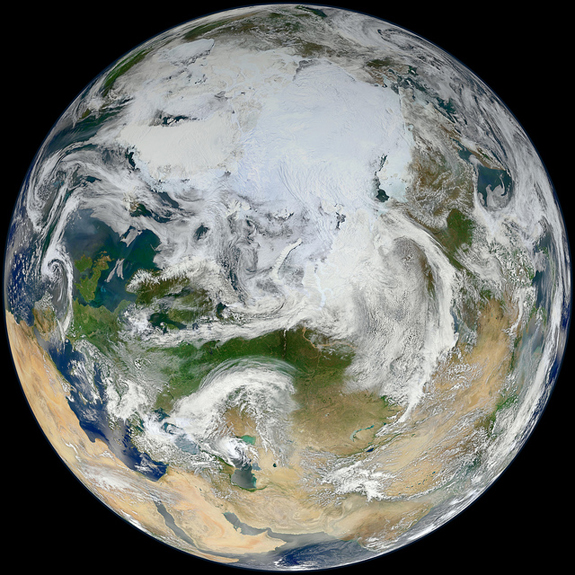The Arctic Hasn’t Been This Hot for 44,000 Years
The average temperature in the Arctic, says new research, is hotter than at any time in the past 44,000 years, and maybe more

Photo: NASA / GSFC / Suomi NPP
Global warming is heating the planet, and the Arctic is getting the worst of it. Polar amplification means that the temperature in the Arctic is rising faster than anywhere on Earth and destabilizing the coast. All that excess heat is also melting ice and snow. While we’ve known that the Arctic is getting warm, according to new research, the weather in the northern regions is actually the warmest it’s been in the past 44,000 years, Christa Marshall reports at Climate Wire.
The average summer temperature in the Arctic over the past 100 years, say lead author Gifford Miller and his colleagues, is “now higher than during any century in more than 44,000 years, including peak warmth of the early Holocene,” a time known as the Holocene thermal maximum.
Getting actual temperature records going back that far is, of course, impossible. Instead, the scientists looked at the plants in the area. By looking at the plants that are emerging from beneath the thawing ice, the scientists can figure out when the ice last melted back this far. Miller and co.:
The ancient rooted plants emerging beneath the four ice caps must have been continuously ice-covered for at least 44 . However, because the oldest dates are near the limit of the radiocarbon age scale, substantially older ages are possible. Based on temperature reconstructions for ice cores retrieved from the nearby Greenland Ice Sheet, the youngest time interval during which summer temperatures were plausibly as warm as present prior to 44 is ~120 , at, or near the end of the Last Interglaciation. We suggest this is the most likely age of these samples.
Regardless of the absolute age uncertainties, it remains clear that these four ice caps did not melt behind our collection sites at any time during the Holocene, but did do so recently, indicating that summer warmth of recent decades exceeded that of any interval of comparable length in >44
The fact that certain ice caps did not melt during the Holocene Thermal Maximum, despite the extreme warmth at the time, suggests that today’s unusual warming period can only be caused by greenhouse gases, Miller said.
“Nothing else out there can explain it,” Miller said.
More from Smithsonian.com:
Everything You Need to Know About Arctic Sea Ice Melt, in One 10-Second Animated Gif
/https://tf-cmsv2-smithsonianmag-media.s3.amazonaws.com/accounts/headshot/smartnews-colin-schultz-240.jpg)
/https://tf-cmsv2-smithsonianmag-media.s3.amazonaws.com/accounts/headshot/smartnews-colin-schultz-240.jpg)